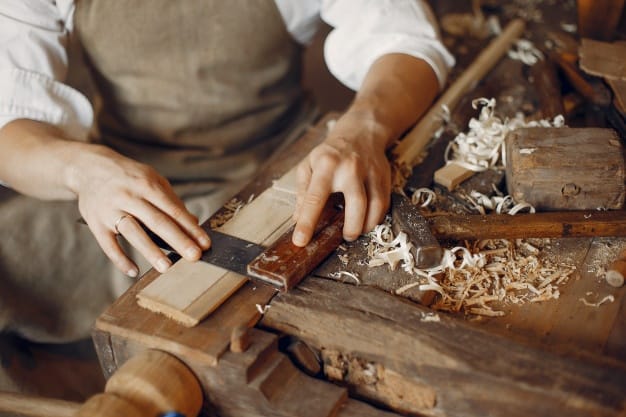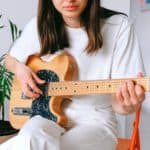Wood is the standard for almost all guitars.
While manufacturers dared to try other materials successfully, it seems that wooden guitars are here to stay for a long time.
The question one should ask is why?
Why are guitars made of wood?
Guitars are made of wood because of tradition and sound preference. The resonance, sustain and overall soul tonewoods provide to the instrument is hardly obtainable with alternatives. What is more, wood is readily available material. It is not only a case of preference but also of convenience and economics.
If you want to understand those reasons thoroughly, then I encourage you to keep on reading.
Aren’t there better materials than wood nowadays?
There are probably better materials to make guitars.
Some of them will be mentioned in this article.
However, most guitarists won’t care whether a different material is “better” than wood.
After all, it might feel off to adapt to a new thing.
Experienced guitarists tend to prefer tradition over innovation.
Sure, it is nice to give anything new a try.
Taking it as a norm is a different story, though.
Why is solid wood the gold standard for guitars?
There’s a good amount of reasons why wood is still the number one option.
First of all, let’s not forget the fact electric guitars evolved from acoustic guitars, which were made out of wood.
If such material worked for acoustics, then why would anyone change it for electrics?
Second, musicians prefer wood because of sound.
Of course, on acoustic guitars, the string vibration produces sound when it passes to the saddle, then the soundboard and the body. Finally, it comes out through the soundhole.
For this reason, wood is a key factor in the final results.
However, while electric guitars rely on other elements to produce their characteristic sound, wood still is one of them.
Wood has gaps, which influence the outcome.
For instance, dense wood (which has few gaps) creates sharper sounds. This is because vibrations have little to no space to move around.
On the other hand, a less dense wood leads to a darker sound.
Those little details are quite big in the long run, which is why solid wood is still a standard for guitars.
It is also relevant to mention wood’s availability. Not only this makes it easier to produce guitars, but also cheaper.
Price, then, is another aspect manufacturers take into account.
Drawbacks of making guitars from wood
The number one drawback that comes to our minds is deforestation.
Sadly, this activity has risen in the last years, affecting climate change and creating floods and soil erosion.
However, one cannot blame guitars manufacturers solely. Plenty of other things is made out of wood.
Either one way or the other, deforestation is still one of its disadvantages.
Another drawback is low-quality woods.
As I mentioned before, wood is relevant for the sound a guitar produces.
Low-quality woods equal low-quality sound, even if the difference seems unnoticeable.
What is more, this type of wood tends to bend the more you use it.
Eventually, what used to be an invisible difference becomes highly visible.
Avoid guitars made out of cheap wood. You’ll regret it.
Finally, some varieties that are harder to work with.
Hard Ash, Mahogany, and Maple tend to be really heavy types of woods.
While those require hard work, the result in sound is impossible to ignore.
Along with this idea, don’t forget that a single guitar is made of different types of wood: one for the body, one for the fretboard, another one for the neck, etc.
This makes it a tough task, especially for those who want to create homemade guitars.
Are guitars made from any other materials?
Sure enough, other materials can replace wood.
For example, synthetic wood, which makes an overall perfect alternative since it resembles real wood.
Medium-density fireboard can’t be out of this topic either.
The only problem with both MDF and synthetic wood is that they are still different types of woods, or at least they are compounds of wood plus another material.
Therefore, it is fair to mention other components such as metal, plastic, fiberglass, lucite, Richlite, or carbon fiber.
As you see, there are quite a few alternatives you can choose from.
Here are some real models, marks, and types of guitars that you can look for:
- Frying pan (while mostly made of steel, some models were made from Bakelite, a type of plastic)
- Danelectro guitars (Pressboard and Plywood)
- Airline resonator guitar (fiberglass)
- Rainsong guitars (most of them are made of carbon fiber)
- National guitars (metal)
There are too, some intrepid musicians who dared build guitars with the materials mentioned recently. Check some Youtube videos and maybe you’ll get inspired to try on new things!
Is there a point in looking for newer materials?
The main point to look for new materials is simply to experiment!
Think about it this way.
There was a time in history when someone said “hey, what if I build something different from this guitar?” Then turned an acoustic into an electric guitar, and the world changed forever.
You might believe I’m exaggerating, but there is an undeniable reality: if you want to innovate and improve, then you need to experiment and take risks.
In other words, looking for new materials to produce guitars could lead to brand new results that might gradually become a tradition.
Who knows? Maybe plastic guitars become the norm in a couple of years.
Maybe not. Maybe wood will keep on living generation through generation.
Another thing to take into account is the ecological aspect.
Reducing wood consumption inevitably reduces deforestation.
Maybe plastic or metal guitars shouldn’t replace wood from one day to the other.
However, normalizing their use in the world of music could be a good idea, and something not to be afraid of.
After all, this can be a small step towards environmental health.
Final thoughts: Why players don’t accept innovation
There’s undeniably an emotional attachment towards wooden guitars.
This doesn’t mean it is necessarily a bad thing.
Instead, it’s a logical explanation.
See, traditions are hard to “kill”. They are hardwired into our minds and hearts.
One grows up admiring Jimi Hendrix, Slash, Angus Young, or Jimmy Page.
We see them playing with wooden guitars.
We want to imitate them. We want to reach such potential.
Why then would we want to eradicate such a powerful symbol? Why change classic wood for “something else”?
Why change something that already works, to begin with?
Well, why not?
Change is inevitable, and we must be both willing and prepared to confront it. To adapt to it.
Every music genre is a recycle of a previous genre. Heavy metal comes from hard rock which comes from classic Rock & Roll, which comes from blues.
This means that change is not only important but good.
Once again, this article was not made with the idea of persuading you to change wood for fiberglass.
I’m not saying that wood guitars should disappear and become a curiosity of the 20th Century.
All I’m saying is that innovation is not something to be afraid of.
Innovation is something to be listened to.

Hello there, my name is Ramiro and I’ve been playing guitar for almost 20 years. I’m obsessed with everything gear-related and I thought it might be worth sharing it. From guitars, pedals, amps, and synths to studio gear and production tips, I hope you find what I post here useful, and I’ll try my best to keep it entertaining also.





